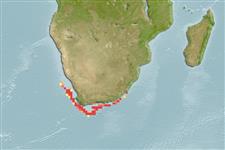Élasmobranches (requins et raies) (sharks and rays) >
Rajiformes (Skates and rays) >
Rajidae (Skates)
Etymology: Neoraja: Greek, neos = new + Latin, raja = fish, Raja sp. (Ref. 45335).
Environment: milieu / climate zone / depth range / distribution range
Écologie
marin bathydémersal; profondeur 102 - 1025 m (Ref. 5578). Deep-water; 29°S - 40°S
Southeast Atlantic: off the Orange River mouth to south of the Agulhas Bank, South Africa.
Taille / Poids / Âge
Maturity: Lm ? range ? - ? cm
Max length : 37.6 cm TL mâle / non sexé; (Ref. 106604)
Description synthétique
Clés d'identification | Morphologie | Morphométrie
A dwarf softnose skate with a bluntly pointed snout and very large close-set eyes; tail longer than body in adult; pectoral disc angular with rounded corners, and anterior edges more undulated in adult male than in female; large thorns around eyes, on shoulders, and in interrupted single row from back to dorsal fins (Ref. 5578). Brownish-grey above, with 6-7 crossbars on tail; underside pale with dark brown areas along the front and rear edges of disc, on snout and on underside of tail (Ref. 5578).
Found on the upper slope (Ref. 5578). Oviparous (Ref. 50449). Eggs have horn-like projections on the shell (Ref. 205). Probably taken by hake trawlers (Ref. 5578).
Life cycle and mating behavior
Maturities | Reproduction | Spawnings | Egg(s) | Fecundities | Larves
Oviparous, paired eggs are laid. Embryos feed solely on yolk (Ref. 50449).
McEachran, J.D. and K.A. Dunn, 1998. Phylogenetic analysis of skates, a morphologically conservative clade of elasmobranchs (Chondrichthyes: Rajidae). Copeia 1998(2):271-290. (Ref. 27314)
Statut dans la liste rouge de l'IUCN (Ref. 130435)
Menace pour l'homme
Harmless
Utilisations par l'homme
Outils
Articles particuliers
Télécharger en XML
Sources Internet
Estimates based on models
Preferred temperature (Ref.
123201): 6.1 - 12.1, mean 10.8 °C (based on 9 cells).
Phylogenetic diversity index (Ref.
82804): PD
50 = 0.5312 [Uniqueness, from 0.5 = low to 2.0 = high].
Bayesian length-weight: a=0.00646 (0.00364 - 0.01145), b=3.29 (3.14 - 3.44), in cm total length, based on LWR estimates for this species & (Sub)family-body (Ref.
93245).
Niveau trophique (Ref.
69278): 3.7 ±0.6 se; based on size and trophs of closest relatives
Résilience (Ref.
120179): Faible, temps minimum de doublement de population : 4,5 à 14 années (Fec assumed to be <100).
Fishing Vulnerability (Ref.
59153): Low to moderate vulnerability (28 of 100).
